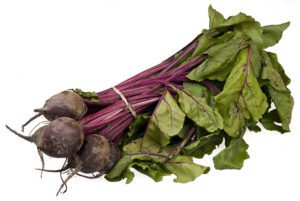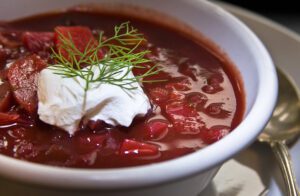George Dunea
Chicago, Illinois, United States
All but the most lionhearted would experience a sinking feeling on finding they have passed blood in their urine. With Sir Walter Scott they might wonder if changing the vowel A to I means they would soon be making earth. They would be greatly relieved to find out that the root cause of their problem was eating what the British call beetroot and the Americans call beets.
The culprit is a flowering plant known as Beta vulgaris. Growing to a height of about 120 cm, it produces white flowers, leaves for salads, and a root or taproot that looks remotely like a potato and is usually dark red. At one time it was used to color wine. It is consumed around the world and has a taste that some people actually like. It can be eaten raw, roasted, boiled, or pickled, in soups and stews. Like many other vegetables, it provides nutrition, some fiber, carbohydrates, a little zinc and iron, and vitamins.
The disease in question, if indeed it can so be called, is beeturia, manifested by the excretion of red or pink urine after eating beets. It is found in over ten percent of the population, perhaps more so in iron deficient individuals or those suffering from intestinal malabsorption. It is harmless except for the fright it can cause, although there are a few reports of people having anaphylactic shock on encountering beets for the first time. Affected people are believed to be homozygous for an autosomal recessive gene and are unable to metabolize pigments such as betanin, which accumulate and are excreted in the urine and sometimes also in the feces.
Beets are often advertised for having antioxidants, nitrates that relax blood vessels and lower blood pressure, as well as being good for the heart, the liver, preventing cancers, enhancing athletic performance, and reducing fatigue. However, it was for nutrition that beets have long been eaten in Eastern Europe as the main constituent of the soup called borscht.
Borscht is believed to have been developed in the tenth century, probably in the Ukraine. It includes cabbage, potatoes, carrots, onions, garlic, and broth. Each country and even each region within a country has its own recipe. In the Ukraine it is usually made with pork, in Russia it often includes beef, poultry, or fish, while Polish borscht tends to be more soured with fermented rye flour or sour cream.
The preparation of borscht requires much attention to detail. The beets are grated or thinly sliced and sautéed with onions and garlic before being simmered in the broth. Cabbage, potatoes, and carrots are added. The soup is then seasoned with herbs such as dill, parsley, and bay leaves, which impart a fragrant aroma. The final touch is adding some sour cream, enhancing the soup’s creaminess and tanginess.
Borscht once held a deep cultural significance in Eastern Europe. It was a symbol of hospitality and a communal affair, with family members coming together to make it, a favorite meal at Christmas and Easter, and a popular choice during cold winter months. It can be adapted to suit dietary preferences such as vegetarian or vegan versions. Medical myths aside, beets have been a staple in Eastern Europe for centuries and have lately crossed the Atlantic to now appear on the menus of America’s trendiest restaurants.
 |
 |
 |
| Photo by Evan-Amos on Wikimedia | Photo (“candid”) by freshtopia.net on Flickr. CC BY-SA 2.0 | Photo (“borscht served”) by liz west on Flickr. CC BY 2.0 |
, MD, Editor-in-Chief

Leave a Reply